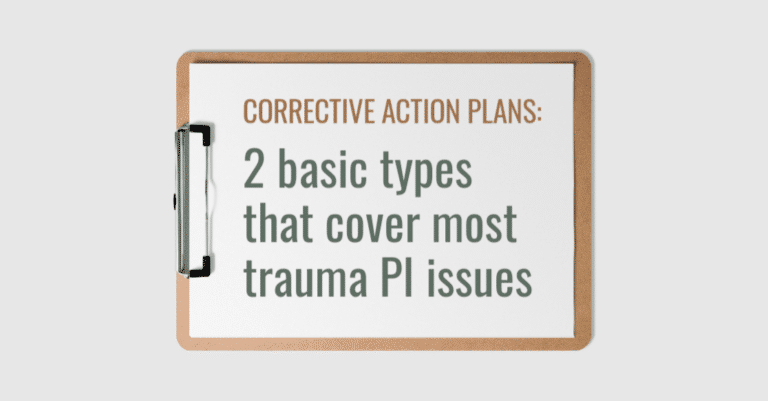Corrective action planning is a required part of loop closure for trauma performance improvement (PI). According to a recent survey, it is also one of the skills that PI leaders most want to improve.
Last month, my team partnered with Trauma System News to survey trauma leaders on their PI program goals. We asked, “What aspects of your trauma PI program do you want to improve within the next 12 months?” The top three responses were:
1. Our ability to demonstrate loop closure (65%)
2. Our ability to achieve timely loop closure (63%)
3. Our ability to develop effective corrective action plans (58%)
It’s no surprise that these three improvement goals topped the list in our Trauma PI Goals Survey. They go hand in hand, because it is very hard to demonstrate loop closure in a timely manner unless you start with a well defined PI plan that includes a solid corrective action plan.
When asked to explain their answers, several survey respondents wrote about the difficulty of identifying a corrective action that will be both appropriate and effective:
- “Figuring out the proper change in patient care to stop a bad patient outcome from occurring is the hardest part of PI.”
- “We need to look for ways to work smarter and more efficiently with the development of action plans and loop closure.”
- “We need better ways to have effective corrective action plans … The plans we have are enlightening (meaning people know about them) but not long-haul effective.”
What is the smart, efficient way to develop corrective action plans that lead to long-term improvements in patient care? The key is to master two basic types of corrective action plan — two versatile strategies that cover the majority of PI issues you will ever face.
When creating a corrective action plan to prevent a trauma PI issue from recurring, most often your trauma team needs either “guardrails” or a “stop sign.”
Guardrails: Guidelines for ensuring best care
Most trauma PI issues can be resolved by simply ensuring that your trauma team adheres to best practices as defined by your program’s clinical practice guidelines (CPGs). The implication is that when you identify a PI problem, the first step should be to examine it in the light of your CPGs.

Let’s use a case example to illustrate. An MVC patient arrives in your trauma bay with hypotension and tachycardia. The patient responds to fluid resuscitation, his blood pressure and heart rate improve, and the FAST exam is negative. The patient is then taken for a CT scan, which shows no evidence of internal bleeding. After admission to the ICU, however, the patient deteriorates. A bedside FAST now shows blood in the abdomen. The patient is taken emergently to the OR, where the team discovers a significant liver injury.
What are the issues that come to mind in this case?
To create an effective corrective action plan for a case like this, first go back and look at the care to identify any failures in established practice or process. In many cases, you will find that what your program needs is a functional CPG that serves as a guardrail to (1) help prevent deviations from best practice and (2) ensure the team recognizes shock in future similar patients.
If your program does not have a CPG for blunt abdominal trauma management, create one. If you do have a guideline, make sure it is up to date. Evidence-based guidelines are available through the Eastern Association for the Surgery of Trauma (EAST), the ACS Trauma Quality Improvement Program (TQIP) and other organizations. In addition, example CPGs are available through several organizations such as the Society of Trauma Nurses, the Trauma Center Association of America and the Pediatric Trauma Society.
Here is another illustration: Your trauma center receives a crash victim with an open femur fracture. While the trauma team fixates on the fracture, they largely overlook a seatbelt injury to the neck. The patient later suffers a stroke caused by an unrecognized vascular neck injury.
Corrective action plan: Create or update your CPG for MVC patients to emphasize assessment for seatbelt neck injuries. Establishing this guardrail makes it less likely that caregivers will miss this injury in future patients.
In both of these examples, it is possible that your program has an up-to-date CPG but the provider did not follow it. If this is the case, the problem is a provider issue. Stronger guardrails may still be beneficial, but the main solution is to activate your peer review process (more on that below).
Remember, a corrective action plan is not loop closure. To close the loop, you need to demonstrate that corrective actions have been effective. After you implement a new or updated CPG, audit for compliance and recurrence for a minimum of 3 months.
Here is another way to look at it: The corrective action plan is the first step in documenting loop closure. The loop is not closed until compliance is met and the issue does not recur.
This 3- to 6-month process of implementing a corrective action and auditing for compliance is timely and effective. Site surveyors find deficiencies in your PI process when issues or events remain open because there has been a failure to either create a corrective action plan or audit for compliance.
Stop signs: Policies aimed at major risks
Other trauma PI issues involve major risks that require a different approach. Guardrails in the form of clinical guidelines may still have a role to play in corrective action, but the severity and specificity of the problem call for a policy change. The trauma program needs to adopt a “stop sign” policy to guard future patients from a similar bad outcome.
For example, many trauma centers use pseudonyms (e.g., “John Doe”) for unidentified patients requiring trauma team activation. Issues arise when multiple patients arrive consecutively, creating the opportunity for mislabeling blood specimens.

What is the right corrective action for this PI problem? Harm did not reach the patient so this situation did not qualify as a sentinel event. However, it did highlight a significant risk in existing processes. To mitigate this risk, the trauma program enlisted the help of the hospital quality department to perform a Failure Mode and Effects Analysis (FMEA).
The FMEA resulted in creating a “time-out” for patient identification at the start of every trauma resuscitation. Every team member must stop what they are doing to listen to the EMS report and verify the patient armband and pre-printed labels. The only exception to this policy was cardiopulmonary arrest. The process was audited for compliance prior to closing the loop on the event.
A few things are worth noting. First, this problem was not a “guidelines issue” because the trauma team had guidelines for nearly every aspect of this patient’s care. Second, the problem was not just a deviation from best practices but a potentially catastrophic error. The team did not need a CPG, it needed a “hard stop” process to protect future patients from a similar near miss.
That brings up an important question: How do you show loop closure when a similar issue reoccurs? Repeat the process:
- Identify what part of your previous corrective action plan went wrong or fell short.
- Revise your guardrail or stop sign or devise a new one.
- Implement the plan and audit for compliance and/or recurrence.
More strategies for trauma PI
In my experience, “guardrail” and “stop sign” corrective actions cover most of the PI issues that trauma leaders encounter. However, there are other kinds of problems that call for different approaches.
The simplest are equipment problems. In the liver injury example above, the missed diagnosis could be due to problems with the trauma team’s ultrasound device. PI leaders should keep this possibility in mind as they review issues. In addition, make sure your FAST images are included in your hospital’s regular QA process.
At the other end of the spectrum, the most difficult PI problems are provider issues — where the root issue is an individual error in judgment, treatment, technique, or another aspect of care. Provider issues require a carefully structured plan that begins with targeted education and can be escalated in a deliberate manner.
Angie Chisolm, MBA, BSN, RN, CFRN, TCRN is managing partner at Peregrine Health Services. She is a nationally recognized expert in trauma program operational efficiency, coding and billing, site survey readiness and performance improvement. Angie is also chief operating officer and co-founder of National Quality Systems (NQS), a data management platform for trauma centers.


2 Comments
I am not able to register for the webinar in August. I get an expired message
Julie, sorry for the confusion. You accessed the registration for a previous webinar.
To sign up for the upcoming August 2022 webinar, visit this page and scroll to the bottom: https://trauma-news.com/2022/07/how-to-document-the-effectiveness-of-your-trauma-pips-program/.
Thanks!
Bob Fojut, Editor